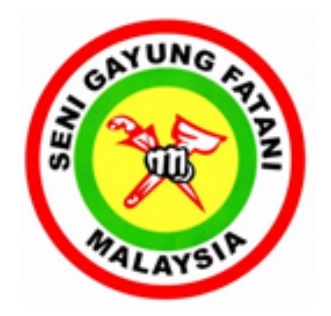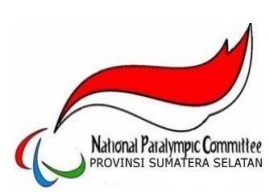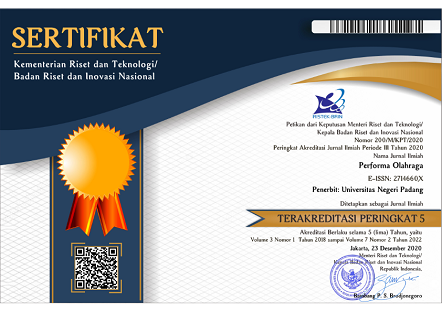The Physical Performance Needs in Silat Olahraga
A Coaching Perspective to Establish Plyometric Training in Silat Combat Sport
DOI:
https://doi.org/10.24036/jpo363019Keywords:
Combat Sports, Martial Arts, Conditioning, Fighting, Sports CoachingAbstract
Study Purpose. Combat sports have been classified as grappling, for example, karate, silat, taekwondo, jitsu, judo, wrestling) and striking, as silat, karate or taekwondo depending on their rules and technical actions. As the technical movement and rules vary depending on the sport, it is plausible that physical fitness necessities to achieve high-level in each combat sport are also different.
Materials and Methods. Despite their determination and identity, the physical and physiological profiles of all combat sports, there were less investigation can be proven on the effects of plyometric training in silat.
Results and Discussions. This current information could be useful for athletes’ detection programs for the different combat sports. Based on the past research that have been done, it’s have been proved that less research is being done on plyometric training in silat and predominantly on the main physical fitness performance needs (power, agility, cardiovascular endurance, and muscular strength).
Conclussions. Coach as a full drill power in kick and handReferences
Adams, T.M., Worley, D., & Throgmartin. D. (1984).An investigation of selected plyometric training exercises on muscular leg strength and power. Track Field Q. Rev., 84,36-40.
Alptekin, A., Kilic, O., & Mavis, M. (2013). The effect of an 8-week plyometric training program on sprint and jumping performance. Serbian Journal of Sports Sciences,7 (2),45-50.
Anderst, W.J., Eksten, F. and Koceja, D.M. (1994). Effects of plyometric and explosive resistancetraining on lower body power. Medicine andScience in Sport and Exercise 26,S31.
Anuar, A.W. (1993). Silat Olahraga (2nd edn.). The art, technique and regulations. Kuala Lumpur: Dewan Bahasa dan Pustaka.
Anuar, A.W. (2007). Silat. Pendididkan dan Nilai-nilai Murni dalam Seni Silat Melayu tradisi dan pembentukan kokurikulum Silat Malaysia moden (Silat: The development history of traditional Malay Silat and development of modern Silat Malaysia curriculum). Bandar Baru Bangi, Selangor: Hizi Print sdn Bhd.
Aziz, A. R., Tan, B., & Teh, K. C. (2002). Physiological responses during matches and profile of elite pencaksilatexponents. Journal of Sports Science & Medicine, 1(4), 147-155.
Baechle, T. R., Earle, R. (2000). NSCA?s Essentials of Personal Training: National Strength and Conditioning Association.
Birds, S. & Davidson, R. (1997). Physiological testing guidelines (3rdedition). Leeds: The British Association of Sport and Exercise Sciences.
Blaevi, S., Kati, R., & Popovi, D. (2006). The effect of motor abilities on karate performance. Coll. Antropol, 30(2), 327-333.
Bompa, T.O. (1996). Periodization of strength, (4thed.). Toronto: York University. Human Kinetics.Bompa, T.O. (1999).Periodization: Theory and methodology of training. Toronto: York University. Human Kinetics.
Clutch, D., Wilton, M., Mcgown, C., & Bryce, G.R. (1983). The effect of depth jumps and weight training on leg strength and vertical jump.
Davaran, M., Alireza, E., Hamid, A. (2014). The effect of a Combined (Plyometric –Sprint) Training Program on Strength, Speed, Power and Agility of Karateka Male Athletes. Research Journal of Sports Science, Vol 2 (2): 38-44.
Dahlia Al-Syurgawi, Hazim Samsudin, Syahida Mohd Nazri, Nasru Syazwan Nawai, Mohamad Nizam Mohamed Shapie(2022)Jurnal Performa OlahragaVolume 7Nomor 2, 2022, Hlm 90-97.
Gehri, D.J., Ricard, M.D., Kleiner, D.M., & Kirkendall, D.T. (1998). A comparison of plyometric training techniques for improving vertical jump ability and energy production. Journal Strength Conditioning Res., 12, 85–89.Hagl, S. (2003).Study of various leaps and power-enhancing exercises. From the worldwide. Web: http:// www. hausarbeiten.de/faecher/hausarbeit/spc/2 3805.html.
Hughes, M. & Franks, I.M. (2004). Examples of notation systems, In M. Hughes &I.M. Franks (Eds.) Notational analysis of sport (2nd edn.), pp.141-165. London: Routledge.
Holcomb, W.R., Lander, J.E., Rutland, R.M. and Wilson, G.D. (1996) A biomechanical analysis of the vertical jump and three modified plyometric depth jumps. Journalof Strength and ConditioningResearch 10,83-88.Lori, A. (1996). Plyometrics for volleyball. (In: Best of Coaching Volleyball, Book III: TheRelated Elements of the Game. American Volleyball Coaches Association.
Markovic, G., Misigoj-Durakovic, M &Trninic, S. (2005). Fitness profile of elite Croatian female taekwondo athletes. Collegium Antropologicum, 29(1), 93-99.
Martel, G.F., Harmer, M.L., Logan, J.M., and Parker, C.B (2005). Aquatic plyometric training increases vertical jump in female volleyball players. Journal Medicine and Science in Sport and Exercise, 37(10), 1814-1819.
Milic, V., Nejic, D. & Kostic, R. (2008). The effect of plyometric training on the explosive strength of leg muscles of volleyball players on single foot and two-foot take off jumps. Scientific paper (2008).Physical Education and Sport Vol. 6, No 2, 2008, pp. 169 –179. Serbian State University at Novi Pazar.
Miller, J.M., Hilbert, S.C. and Brown, L.E. (2001) Speed, quickness, and agility training for senior tennis players. Strength and Conditioning 23(5), 62-66.
Miller, M. G., Herniman, J.J., M. D., Cheatham, C.C. & Micheal, T.J. (2006). The Effects of 6-Week Plyometric training on agility. Journal of Sports Science and Medicine (2006), 5(3), 459-465.
Mullan, A. & O?Donoghue, P. (2001). An alternative computerized scoring system for amateur boxing. In M. Hughes and I. Franks (Eds.) Pass.com., pp. 359-364. Cardiff: CPA Press, University of Wales Institute, Cardiff.
Paul, E. L., Jeffrey A. P., Mathew W. H., John P. T., Michael J. C., & Robert H. L., (2003). Effects of Plyometric Training and Recovery on Vertical Jump Performance and Anaerobic Power. Journal of Strength and Conditioning Research, 17(4), 704–709.Potteiger, J.A., Lockwood, R.H., Haub, M.D., Dolezal, B.A., Alumzaini, K.S., Schroeder, J.M. and Zebas, C.J. (1999). Muscle power and fibre characteristic following 8 weeks of plyometric training. Journalof Strength and Conditioning Research 13,275-279.
Robinson, B, M., Owens B. (2004). Five-week program to increase agility, speed, and power in the preparation phase of a yearly training plan. Strength Conditioning Journal 26:30–35.
Sankarmani, B., Ibrahim, S., Rajeev, K. R, Alagesa, J. (2012). Effectiveness of Plyometrics and Weight Training in Anaerobic Power and Muscle Strength in Female Athletes.International Journal of Pharmaceutical Science and Health Care Issue 2, Volume 2ISSN: 2249-5738.
Shah, S. (2012). Plyometric exercise. International Journal of Health Science and Research. ISSN: 2249-9571.
ShapieM.N.M. (2011), Influence of Age and Maturation on Fitness Development, Trainability and Competitive Performance in Youth Silat (Doctoral thesis), University of Wales Institute Cardiff.
Shapie, M.N.M. (2020). Sports Science in SILAT: Application of Sports Science in Silat Trainingand Performance. Pertubuhan Seni Gayung Fatani Malaysia. Shah Alam, Selangor, Malaysia. (ISBN: 9789834407629)
Shapie, M.N.M. (2021). The Warrior Attitude (Sikap Pendekar) in Malay Silat Encouraging Malaysian Interest in Global Martial Arts and Combat Sports. In “Southeast Asian Martial Arts: A Unique and Complex Cultural Phenomenon,” Ryu, S., Lee, K. & Hwang, J. (eds); p. 26-95. Chungcheongbuk-do, Korea: International Centre of Martial Arts for Youth Development and Engagement under the auspices of UNESCO [ICM]: Chungju-si. (ISBN: 9791191300239).
Shapie, M.N.M., Oliver, J., O Donoghue, P.G. and Tong, R. (2008), Distribution of fight time and break time in international Silat competition, In “Performance Analysis of Sport VIII,” A. Hokelman, M. Brummond (eds): p. 667-672. Germany: Otto-von-Guericke-Universität Magdeburg, Department of Sports Science, Deutschland.
Shapie, M.N.M, Oliver., O?Donoghue, P.G. and Tong R. (2011). Effect of circuit training on fitness development in youth silat. 5th ISN International Sports Medicine and Sports Science Conference 2011.
Shapie, M.N.M, Oliver, J., O?Donoghue, P.G. and Tong R. (2013a). Activity profile during action time in national silatcompetition. Journal of Combat Sports and Combat sport.Shapie, M.N.M, Oliver., O?Donoghue, P.G. and Tong R. (2013b). Development of new field-based tests of kick and movement speed in youth combat sport. Journal of Combat Sports and Combat sport.
Shapie, M.N.M., Elias, M.S., Anuar, A. (2016). Silat: The Heritage of Malaysia (Silat: WarisanBangsa Malaysia). The National Department for Culture and Arts, Ministry of Tourism and Culture, Kuala Lumpur, Malaysia [In Malay]. (ISBN : 9789675552625)
Shapie M. N. M., Nur Afiqah A. J., Kusrin J., Wahidah T., Elias M.S. (2018a), Activity Profile between Winners and Losers in International Silat Olahraga Matches, “Journal of Physical Fitness, Medicine & Treatment in Sports”, vol. 2(4), 555592; doi: 10.19080/JPFMTS.2018.02.555592.
Shapie M.N.M., Oliver J., O?Donoghue P.G., Tong R. (2018b), Effect of Circuit Training on Fighting Performance of Young Silat Athletes -A Case Study, “Malaysian Journal of Movement, Health & Exercise”, vol. 7 (1), pp. 27-41; doi:https://doi.org/10.15282/mohe.v7i1.199.
Shapie M. N. M., Nur Afiqah A. J., Kusrin J., Wahidah T., Elias M.S. (2018c), Silat Tempur: The Combat Sports for Children, [in:] N. Sulaiman et al. [eds.], Proceedings of the 3rd International Colloquium on Sports Science, Exercise, Engineering and Technology, Springer Nature, Singapore, pp. 151-158.
Stojanovic, T., & Kostic, R. (2002). The effects of the plyometric sport training model on the development of the vertical jump of volleyball players. Facta University Physical Education Sport, 1(9), 11-25 1.
Thomas, T.R., French, K.E. (1985). Gender differences across age in motor performance: ameta-Viitasalo, J. T., Salo, A. and Lahtinen, J., 1998. Neuromuscular functioning of athletes and non-athletes in the drop jump. European Journal of Applied Physiology and Occupational Physiology, 78(5), pp. 432-440.
Wagner, D.R. & Kocak, M.S. (1997). A multivariate approach to assessing anaerobic power following a plyometric training program. Journal Strength Cond. Res.,11, 251-255.
Williams, N. & O?Donoghue, P.G. (2006). Techniques used in mixed-martial arts competition. In H. Dancs, M. Hughes & P.G. O?Donoghue (Eds.) Performance analysis of sport 7, pp. 369-375. Cardiff: CPA Press, University of Wales Institute, Cardiff.
Winter, E.M., Bromley, P.D., Davidson, R.C.R., Jones, A.M. & Mercer, T.H. (2007). Sport and exercise physiology testing guidelines (Volume One).London: The British Association of Sport and Exercise Sciences Guide (BASES).
Yap, C. W.; Brown, L. E. (2000). Development of speed, agility, and quickness for the female soccer athlete. Strength and Conditioning(Vols. 22), p. 9-12. Young, W.B., McDowell, M.H. and Scarlett, B.J. (2001). Specificity of spring and agility training methods.Journal of Strength and Conditioning Research 15,315-319.










.png)





